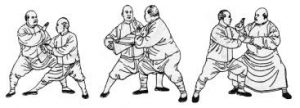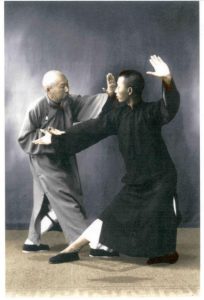Tui Shou Push Hands
This is Tai Chi awareness energy training, developing sensitivity (Ting Jing) listening energy. The student learns the art of sticking and connecting to their partner whilst negating, deflecting and opening their partner’s line of attack. This section is trained slowly to ensure that the body alignment and rooting is understood. Sensitivity can only come about by the softening of the arms, hands – the concept of loosing all tension so that the opponent can be read through feel rather than by sight. This is the basic push hands method used to develop the primary hands – that part of the arm employed from the below the elbow to the fingers.
Primary and Corner Hands
In this section the student learns the corner hands supporting the primary hands; this is the idea of guarding against the elbow and the use of your own elbow in naturalization and projecting techniques, used both form defence and attack. When the lower arms are engaged with the attacker the corner hands are then used. The student learns the art of using the elbows almost like a second set of hands, hence the name corner hands. The skills employed in this section are supported by the skills in the first section, developing more complex manoeuvres to override the opponent’s attack. The student learns to react through feel and over time develops the ability to change in accordance to the many different angles of attack and intensity also. The corner hands also employs other areas of the body such as hip and shoulder are used in the same way as the elbow, the concept of stick is the most important skill in Tai Chi Chuan training.
Structure testing is introduced also, this is the the art of rooting whilst using the skills learnt in section one and two. The use of sensitivity training is of no avail if when touched you are pushed back, or you lose your balance and fall. The idea of soft is not a weak posture but a strong one, soft is used to absorb the force of the attacker, to neutralise, deflect or nullify. In order to make yourself soft you first have to make yourself strong, this is Tai Chi paradox training method, “softness in strength”. Through the structure test method, the student not only begins to understand the concept of rooting, the student can being to soften and relax more and still remain strong, we can then introduced to the student to channelling, absorbing or draining force. Channelling is where the student develops the concept of letting the force of the attacker pass through them, absorb and drain, simultaneously grounding and projecting the force back towards the attacker, this is know as “swallow and spit”. Tai Chi’s method of partnered work differ considerably from other Marital Arts – this has to be felt rather than seen. This section builds power into the student whilst developing Peng Jing energy – the art of expanding into the attacker to uproot them and take control of their centre. Grounding, softening, absorbing and projecting skills are developed in this section.

